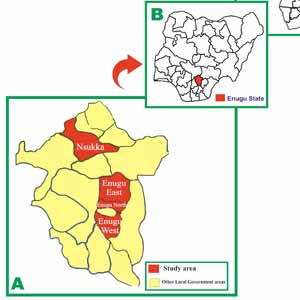Prevalence, characterization, antimicrobial susceptibility pattern and factors associated with group B streptococci (Streptococcus agalactiae) from clinical and non- clinical sources in South-East Nigeria

Accepted: May 9, 2022
All claims expressed in this article are solely those of the authors and do not necessarily represent those of their affiliated organizations, or those of the publisher, the editors and the reviewers. Any product that may be evaluated in this article or claim that may be made by its manufacturer is not guaranteed or endorsed by the publisher.
Authors
Many years ago most human infections caused by aerobic streptococci, were attributed to Lancefield groups A and D or to the so called non-groupable viridans streptococci. The first human isolates of the Group B Streptococci (GBS) were isolated from the vagina of post-partum women. This study is aimed at assessing GBS colonization of some clinical and common non-clinical surfaces. This study utilized a total of 615 samples (300 clinicals and 315 non-clinicals). Samples were from neonates and women who were respectively seen at the Institute of Child Health, of the University of Nigeria Teaching Hospital and Amblim Reference Laboratory in Enugu. The 300 clinical samples were cultured from 119 pregnant and 79 non-pregnant women, 52 neonates and 25 (7 primary and 18 secondary infertility) infertile couples (50 individuals). All samples were cultured on a modified Islam medium and identification carried out using standard bacteriological methods. Characterizations of the GBS isolates were carried out using sodium hippurate reactions, aesculin reactions, Christie, Atkin Muchin–Patterson (CAMP) test and definite hydrolysis on blood agar. The overall GBS isolation of 15.8% was observed in the clinical and non-clinical surfaces assessed. For the clinical subjects, GBS colonization of 11.9%, 7.6%, 9.6% and 17.0% were observed in the pregnant women, non-pregnant women, neonates and couples admitted for infertility. Prevalence of GBS isolation on inflamed cattle udder and milk products were 4.0% and 83.3%, respectively. Gestational period was associated with GBS colonization in pregnant women. All the GBS isolates were susceptible to penicillin and methicillin while all were resistant to streptomycin, tetracycline and sulphafurazole. GBS colonization of vagina was found and this poses a risk for neonatal sepsis.
How to Cite

This work is licensed under a Creative Commons Attribution-NonCommercial 4.0 International License.
PAGEPress has chosen to apply the Creative Commons Attribution NonCommercial 4.0 International License (CC BY-NC 4.0) to all manuscripts to be published.

 https://doi.org/10.4081/jbr.2022.9922
https://doi.org/10.4081/jbr.2022.9922



